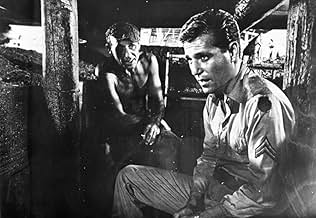CALIFICACIÓN DE IMDb
7.5/10
5.3 k
TU CALIFICACIÓN
El cabo King, un traficante de ruedas que habla rápido, está atrapado en un campo de prisioneros de guerra malasio durante la Segunda Guerra Mundial y utiliza el soborno y el hurto para hace... Leer todoEl cabo King, un traficante de ruedas que habla rápido, está atrapado en un campo de prisioneros de guerra malasio durante la Segunda Guerra Mundial y utiliza el soborno y el hurto para hacerse con el control de facto del campo.El cabo King, un traficante de ruedas que habla rápido, está atrapado en un campo de prisioneros de guerra malasio durante la Segunda Guerra Mundial y utiliza el soborno y el hurto para hacerse con el control de facto del campo.
- Dirección
- Guionistas
- Elenco
- Nominado a 2 premios Óscar
- 3 nominaciones en total
Joe Turkel
- Dino
- (as Joseph Turkel)
Michael Stroka
- Miller
- (as Mike Stroka)
- Dirección
- Guionistas
- Todo el elenco y el equipo
- Producción, taquilla y más en IMDbPro
Opiniones destacadas
This film, the best of 1965, was tough and disturbing and seriously under-rated. Great performances and a haunting soundtrack. George Segal, one of the best actors of the 60's and 70's creates an insidious yet charming character who runs things in the camp. James Fox (excellent actor who quit for many years on some kind of spiritual journey) is superb as is Tom Courtney and even Patrick O'Neal (who has never been impressive in any other film I can think of) delivers a punch as Max the stooge.
Bryan Forbes created a somber world of dog eat dog that should have been up for a host of awards. Throw in John Mills, James Donald and other familiar faces and you have a near-classic. A 9 out of 10. Best performance George Segal. Well worth your time.
Bryan Forbes created a somber world of dog eat dog that should have been up for a host of awards. Throw in John Mills, James Donald and other familiar faces and you have a near-classic. A 9 out of 10. Best performance George Segal. Well worth your time.
I saw this movie again recently and had forgotten how great it was. It shows how people behave towards each other when the thin veil of civil society is torn away.In a brilliant performance, George Segal plays the wheeler-dealer 'King Rat, a cynical hustler whose only real interest is himself. His counterparts in the Japanese POW camp are the British officers who seem to maintain the rules and courtesies of civilized life. As the movie, unfolds, though, we see the senior officers using their position to steal food from the lower ranks. Even the British provost marshal, or camp policeman (another great performance by Tom Courtenay), is shown to be a weak character, vengeful and sanctimonious, who must believe in retribution to bolster his fragile ego.
'King Rat's' one true friend in the camp is played by James Fox. But the Segal character can't really be a friend to anyone. One of the prices of cynicism is emotional shallowness. In the end Segal tells his best friend - 'You worked for me, I paid you a few bucks, that's all there was between us.' The film makes it clear that the action applies to the wider world. Unlike the other prisoners, the Segal character is neither shocked nor excited by liberation. To him, the everyday world is as pitiless as the POW camp.
'King Rat's' one true friend in the camp is played by James Fox. But the Segal character can't really be a friend to anyone. One of the prices of cynicism is emotional shallowness. In the end Segal tells his best friend - 'You worked for me, I paid you a few bucks, that's all there was between us.' The film makes it clear that the action applies to the wider world. Unlike the other prisoners, the Segal character is neither shocked nor excited by liberation. To him, the everyday world is as pitiless as the POW camp.
It has always bothered me that King Rat is so underrated. On one list of top the thousand films in history, it gets no mention. I think it's because George Segal's character, Corporal King wasn't a totally likable person. He is not the standard Hollywood hero. But he is a hero of mine. Were I in that prison camp, I guarantee you, I would have been Corporal King's best friend. One thing I learned in life was how to survive, and everyone around Corporal King survived. The movie misses a very important point that was in James Clavell's novel on which it is based. In case the war turned bad for the Japanese and they started taking revenge on the prisoners, King had planned an escape route. Not just for himself, for everyone close to him. Put that in the film and you've got a major American hero. The movie is totally cliché free. One never knows where it is going or how it is going to end. Winning the war, you see, will not guarantee the safety of the prisoners. How it ends is perfectly logical in retrospect, but difficult to predict. It is a near perfect motion picture.
I saw "King Rat" on television shortly before going to Vietnam. A few months later I was reading the James Clavell novel while serving on DaNang Air Base with air force communications intelligence. It struck me that this book and this movie, which was "researched" by James Clavell when he was a POW in a camp near Singapore during World War II, have the real feel of what it is to be surrounded by enemy forces one almost never sees while being kept isolated on a hot, humid, dusty encampment It's an environment that brings out the best and the worst in mankind. The novel, the movie, and my own war zone experience also point out that adapting to a war zone and mastering the skills that enable one to survive and even prosper there do not necessarily mean that the individual will subsequently be adaptable to "civilization" when he returns to it. The novel, the movie, and my own experiences also raise the questions that are raised in "The Man in the Gray Flannel Suit" (and even in "Rambo" for that matter): Which is more of a challenge and which is the "real" life: adapting to the war zone as a youth or the expectations by "civilization" that you readjust to life back in "the world" as if nothing had happened?
I don't know exactly what I expected from "King Rat," but what I got definitely wasn't it, and I liked what I got much more than whatever it was I thought I was going to get.
I guess I thought "King Rat" was going to be something along the lines of "Stalag 17," a serious story in a serious setting, but with a buddy movie vibe and a lot of comedy thrown in. That is most certainly NOT what this movie is. "King Rat" is instead a bleak, haunting, and rather strange film about the simple act of survival in a Japanese prisoner camp during the last days of WWII. It's episodic in nature, detailing one grueling incident after another. It explores the degree to which imprisoned military men will impose a hierarchy one way or another, one that either does or doesn't always match the hierarchy of their military lives when free men. For example, at the top of the pecking order in this prison camp is George Segal, the eponymous king rat, who will stop at nothing to ensure his own comfort and who's an object of awe and even fear to those around him, even officers who outrank him. But then the war ends, the prisoners are set free, and everything goes back to the way it was. Where does that leave things like friendship, community, and just simple camaraderie, and where does that leave the conscience of men like King Rat, who exploited his brothers for all they were worth when times were tough.
The movie is tremendous, the performances are all uniformly fine, and director Bryan Forbes gives everything a naturalistic tone that makes the film feel like a product from a later date.
"King Rat" received Oscar nominations for its truly impressive art direction and cinematography, both in the black and white categories back in the days when distinctions were made between B&W and color films.
Grade: A
I guess I thought "King Rat" was going to be something along the lines of "Stalag 17," a serious story in a serious setting, but with a buddy movie vibe and a lot of comedy thrown in. That is most certainly NOT what this movie is. "King Rat" is instead a bleak, haunting, and rather strange film about the simple act of survival in a Japanese prisoner camp during the last days of WWII. It's episodic in nature, detailing one grueling incident after another. It explores the degree to which imprisoned military men will impose a hierarchy one way or another, one that either does or doesn't always match the hierarchy of their military lives when free men. For example, at the top of the pecking order in this prison camp is George Segal, the eponymous king rat, who will stop at nothing to ensure his own comfort and who's an object of awe and even fear to those around him, even officers who outrank him. But then the war ends, the prisoners are set free, and everything goes back to the way it was. Where does that leave things like friendship, community, and just simple camaraderie, and where does that leave the conscience of men like King Rat, who exploited his brothers for all they were worth when times were tough.
The movie is tremendous, the performances are all uniformly fine, and director Bryan Forbes gives everything a naturalistic tone that makes the film feel like a product from a later date.
"King Rat" received Oscar nominations for its truly impressive art direction and cinematography, both in the black and white categories back in the days when distinctions were made between B&W and color films.
Grade: A
¿Sabías que…?
- TriviaDue to the cast, director and setting, this is often assumed to be a British movie, but it was entirely filmed in California.
- ErroresThe shoulder patch that Cpl. King (George Segal) is wearing is that of the 34th Infantry Division (Red Bull). The 34th ID served in the European Theater of Operations, not in the Pacific. The 34th ID patch is a black Mexican water jug called an "olla" with a red bull's skull superimposed. Almost all the POWs at Changi were British or Commonwealth soldiers captured at the surrender of Singapore on Feb. 15, 1942, but there also were POWs from the Netherlands East Indies, which surrendered in March. The only sizable U.S. unit at Changi was Co. E, 2nd Btn, 131st Field Artillery Regt., part of the Army's 36th ID (the "Texas Division"). The Second Battalion, which became known as the Texas National Guard's "Lost Battalion," was detached from the 36th ID in the States and shipped to the Pacific in November 1941, but when the Japanese attacked the Philippines in December, the battalion's convoy was diverted from Manila to Brisbane, Australia. In January the battalion was sent to Java, in the Netherlands East Indies. The battalion was the only U.S. ground unit in Java when the NEI surrendered to the Japanese on March 9, 1942. Most men in the battalion were transferred to Singapore later that year and, along with thousands of British and Commonwealth soldiers, were used by the Japanese as slave labor to build the infamous "Death Railway" connecting Bangkok to Rangoon. Company E of the 2nd Battalion, separated from the rest of the unit on Java, was at Changi briefly in October-November 1942 before being sent to Japan as slave laborers. It would be plausible that Cpl. King was a member of 2nd Battalion, 131st Field Artillery, and that the movie's costumers got the wrong division patch for his uniform.
- Créditos curiosos[Prologue] This is not a story of escape. It is a story of survival.
It is set in Changi Jail Singapore, in 1945
The Japanese did not have to guard Changi as a normal prison of war camp. The inmates of Changi had no friendly Swiss border or any other neutral country within reach. They were held captive not so much by high walls, or barbed wire, or machine-gun posts, but by the land and sea around them - and the jungle was not neutral, nor was the ocean.
They did not live in Changi. They existed. This is the story of that existence.
- ConexionesFeatured in A Walk on the Moon (1999)
- Bandas sonorasAdeste Fideles
(uncredited)
Written by Frederick Oakeley (1841)
Variation sung in distant background by POWs
Selecciones populares
Inicia sesión para calificar y agrega a la lista de videos para obtener recomendaciones personalizadas
- How long is King Rat?Con tecnología de Alexa
Detalles
- Tiempo de ejecución2 horas 14 minutos
- Color
- Relación de aspecto
- 1.85 : 1
Contribuir a esta página
Sugiere una edición o agrega el contenido que falta

Principales brechas de datos
By what name was El caudillo de los desalmados (1965) officially released in India in English?
Responda


































